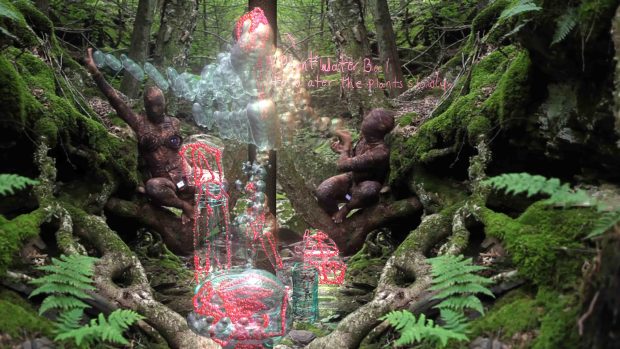We are excited to welcome graduate student Caroline McCraw to write for us this week. In her essay, McCraw discusses Satterwhite’s body of work, which combines dance, 3D animation, and the family archive.

Jacolby Satterwhite is a New York-based artist from Columbia, SC, whose multidisciplinary work explores identity and personal history through video, performance, animation, drawing, and printmaking. After studying painting at the Maryland Institute College of Arts (BFA 2008) and the University of Pennsylvania (MFA 2010), Satterwhite began to focus on performance and animation as a way to examine personal and public mythologies through the signification of his own body. Satterwhite has gained attention for his original approach to integrating CGI technology, family archive, pop culture, dance performance, and fantasy.
Many of Satterwhite’s pieces incorporate drawings and text from his mother, Patricia Satterwhite, who sketched hundreds of domestic inventions while dealing with mental illness. Jacolby Satterwhite uses these drawings as inspiration for dance movements and also transcribes them into 3D forms through a meticulous digital tracing process. In The Matriarch’s Rhapsody (2012), Satterwhite situates family photographs alongside copies of his mother’s drawings and his own animated reproductions of the drawings. This rearrangement and digitalization of a family archive is taken even further in Reifying Desire (2011-2014), a series of six videos wherein his mother’s inventions appear alongside Satterwhite’s own body in phantasmagoric animated environments.
Satterwhite cites many influences, including video games, Janet Jackson, voguing, Fluxus, William Forsythe’s choreography, queer phenomenology, Renaissance painting, and of course, his mother. While Satterwhite turned to animation as a way to access his own voice beyond the constraints of the Western painting canon, the videos maintain a painterly attention to composition and tactility, with swinging shots that explore the dense and ever-mutating imagery. The animations move and rearrange, push and pull, morph, fill, and empty to the beat of dance music. His mother’s sketches hover and shift throughout the shots like pop-up advertisements that grow to become part of the landscape.

In Reifying Desire 5 (2012), the animated bodies of five women sensually pose in a replication of Picasso’s Les Demoiselles d’Avignon (1907). Satterwhite’s own body, filmed in front of a green screen, flies above them. Flashes of the original painting appear, and a digital transcription of one of his mother’s sketches dangles above the women like a neon sign: “For Pussy Power, pour bubble bath into the bathtub into the water and soak for a while to turn the smell of pussy off.” The text functions as both an inspiration and caption for his work; the simultaneous presence of the domestic, erotic, and cosmic allows for Satterwhite to question the limits of a space and the limits of a body.
In Reifying Desire 3 (2012), an androgynous figure’s stomach is probed by several other figures before ultimately giving birth to a glowing, scribbled cross. Satterwhite is likewise gestating and producing a new lexicon of movements and images necessary for discussing those experiences that defy the borders of identity, politics, and language. While Reifying Desire is about the manifestation of desires, whether erotic or entrepreneurial or societal, it is also about desire for the reification of that which is marginalized.